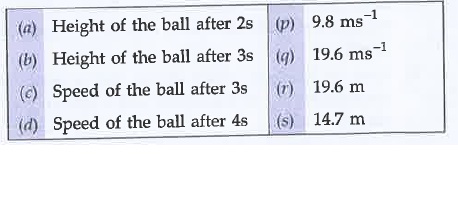A food packet is released from a helicopter which is rising steadily at 2ms−1 , After two second (i) What is the velocity of the packet ? (ii)How far is it below the helicopter?
Take g=9.8ms−2 .
To solve the problem step by step, we will break it down into two parts as per the question.
Given Data:
- Initial velocity of the helicopter (u_h) = 2 m/s (upward)
- Acceleration due to gravity (g) = 9.8 m/s² (downward)
- Time (t) = 2 seconds
Part (i): Finding the velocity of the packet after 2 seconds
1. Determine the initial velocity of the packet (u):
When the packet is released from the helicopter, it has the same initial velocity as the helicopter. Therefore, the initial velocity of the packet is:
u=+2m/s(upward direction is positive)
2. Determine the acceleration of the packet:
The only acceleration acting on the packet after it is released is due to gravity, which acts downward. Thus, the acceleration (a) is:
a=−g=−9.8m/s2
3. Use the first equation of motion to find the final velocity (v):
The first equation of motion is given by:
v=u+at
Substituting the values:
v=2m/s+(−9.8m/s2)×2s
v=2m/s−19.6m/s
v=−17.6m/s
The negative sign indicates that the velocity is directed downward.
Part (ii): Finding how far the packet is below the helicopter
1. Determine the relative motion:
We need to find the displacement of the packet with respect to the helicopter. The acceleration of the helicopter is zero since it is moving at a constant velocity.
2. Calculate the initial velocity of the packet with respect to the helicopter (u_rel):
Since both the helicopter and the packet have the same initial velocity when the packet is released:
urel=u−uh=2m/s−2m/s=0m/s
3. Calculate the acceleration of the packet with respect to the helicopter (a_rel):
The acceleration of the packet relative to the helicopter is:
arel=a−0=−9.8m/s2
4. Use the second equation of motion to find the displacement (s):
The second equation of motion is given by:
s=urelt+12arelt2
Substituting the values:
s=0×2+12×(−9.8)×(22)
s=0+12×(−9.8)×4
s=−19.6m
The negative sign indicates that the packet is 19.6 meters below the helicopter.
Final Answers:
(i) The velocity of the packet after 2 seconds is -17.6 m/s (downward).
(ii) The packet is 19.6 meters below the helicopter.
- Initial velocity of the helicopter (u_h) = 2 m/s (upward)
- Acceleration due to gravity (g) = 9.8 m/s² (downward)
- Time (t) = 2 seconds
When the packet is released from the helicopter, it has the same initial velocity as the helicopter. Therefore, the initial velocity of the packet is:
u=+2m/s(upward direction is positive)
The only acceleration acting on the packet after it is released is due to gravity, which acts downward. Thus, the acceleration (a) is:
a=−g=−9.8m/s2
The first equation of motion is given by:
v=u+at
Substituting the values:
v=2m/s+(−9.8m/s2)×2s
v=2m/s−19.6m/s
v=−17.6m/s
The negative sign indicates that the velocity is directed downward.
We need to find the displacement of the packet with respect to the helicopter. The acceleration of the helicopter is zero since it is moving at a constant velocity.
Since both the helicopter and the packet have the same initial velocity when the packet is released:
urel=u−uh=2m/s−2m/s=0m/s
The acceleration of the packet relative to the helicopter is:
arel=a−0=−9.8m/s2
The second equation of motion is given by:
s=urelt+12arelt2
Substituting the values:
s=0×2+12×(−9.8)×(22)
s=0+12×(−9.8)×4
s=−19.6m
The negative sign indicates that the packet is 19.6 meters below the helicopter.
(i) The velocity of the packet after 2 seconds is -17.6 m/s (downward).
(ii) The packet is 19.6 meters below the helicopter.
Topper's Solved these Questions
- MOTION IN ONE DIMENSIONBOOK - SL ARORACHAPTER - MOTION IN ONE DIMENSIONEXERCISE - problem
19 Videos
- MOTION IN ONE DIMENSIONBOOK - SL ARORACHAPTER - MOTION IN ONE DIMENSIONEXERCISE - problems for self practice
66 Videos
- Motion in a PlaneBOOK - SL ARORACHAPTER - Motion in a PlaneEXERCISE - Excercise
397 Videos
- OSCILLATIONSBOOK - SL ARORACHAPTER - OSCILLATIONSEXERCISE - Exercise
233 Videos
Similar Questions
A food packet is released from a helicopter which is trising steadily at 3ms−1. After 3seconds, (i) what is the velocity of the packet? (ii) how far is it below the helicopter ? Take g=9.8m/s2.
View SolutionA packet is dropped from a helicopter, which is ascending at a rate of 16m/s , when it is at a height of 14.4m above the ground.
(i) How much time it will take the packet to reach the ground?
(ii) With what velocity it will hit the ground?
View Solution
Knowledge Check
A ball is dropped from a balloon which is rising up with a speed of 2 m/s. After 2 s the velocity of the packet is
A20 m/sB18 m/sC22 m/sDnoneA packet is dropped from a balloon which is going upwards with the velocity 12m/s. The velocity of the packet after 2 seconds will be
A−12m/sB12m/sC−7.6m/sD7.6m/sA packet is dropped from a helicopter rising up with velocity 2ms−1. The velocity of the packet after 2 seconds will be
A18 m/sB10 m/sC8 m/sD2 m/s
Matching type Question : A ball thrown up is caught by the thrower after 4s. Take g=9.8ms−2.

View SolutionMass of a body is 5 kg. What is its weight? [Take g=9.8ms−2]
View SolutionWhat is the mass of an object whose weight is 49 newtorn? [Take g=9.8ms−2]
View SolutionA body is thrown horizontal from the top of a tower and strikes the ground after two seconds at angle of 45∘ with the horizontal. Find the height of the tower and the speed with which the body was thrown. Take g=9.8ms−2.
View SolutionA packet is released from a balloon which is moving upward when the balloon is at a height 200 m above ground. The packet reaches the ground in 8 sec. Speed of the balloon when the packet is released, is: (Take g=10m/s2)
View Solution
